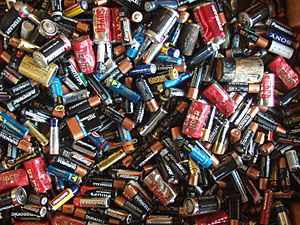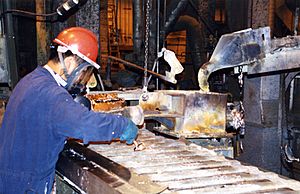Battery recycling facts for kids
Many batteries get thrown away after they are used up. Battery recycling is a special way of collecting these batteries so they can be handled safely. Batteries contain different metals like lead, copper, or zinc. When these metals are in batteries, they can be very bad for the environment. Most of them are even toxic, which means they can be harmful.
Collecting batteries allows us to take out some of these metals. These metals can then be used again to make new things. This stops them from being thrown away. The parts that cannot be used again are handled in a way that is much safer for the environment. Because of this, many countries have rules. These rules say that a certain amount of all used batteries must be recycled.
Contents
Why Recycle Batteries?
Batteries are super useful in our daily lives. They power everything from our phones to remote controls. But when they run out of energy, they don't just disappear. They contain special chemicals and metals. These can be very harmful if they end up in regular trash.
- Protecting the Earth: When batteries are thrown away, harmful substances can leak out. These can get into the soil and water. This pollution can hurt plants, animals, and even people. Recycling helps keep these bad chemicals out of our environment.
- Saving Resources: Batteries are made from valuable metals like nickel, cadmium, lithium, and lead. When we recycle batteries, we can get these metals back. Then, they can be used to make new batteries or other products. This means we don't have to dig up as much new material from the Earth. It saves energy too!
- Following the Rules: Many places have laws about recycling batteries. This is because governments know how important it is for our planet. By recycling, we help our communities follow these important rules.
What Happens When Batteries Are Recycled?
Recycling batteries is a bit like taking apart a puzzle. Here's a simple look at what happens:
Collecting Batteries
The first step is to gather all the used batteries. You might see special collection bins at stores, schools, or recycling centers. It's important to put batteries in these special bins. This keeps them separate from other trash.
Sorting Batteries
Once collected, batteries are sorted by their type. There are many different kinds of batteries. Some common types are:
- Alkaline batteries: These are common in things like flashlights.
- Lithium-ion batteries: Found in phones and laptops.
- Lead-acid batteries: Used in cars.
- Nickel-cadmium (NiCd) and Nickel-metal hydride (NiMH) batteries: Often found in rechargeable devices.
- Button cells: Small, round batteries for watches or hearing aids.
Each type needs a different recycling process. This is because they are made of different materials.
Processing and Reclaiming Materials
After sorting, the batteries go to special recycling plants. Here, machines and chemicals are used to break them down. The goal is to separate the valuable metals and other materials.
For example:
- Lead-acid batteries are often melted down. The lead is then cleaned and used again.
- Nickel-cadmium batteries can have their nickel and cadmium recovered.
- Lithium-ion batteries are more complex. Their lithium, cobalt, and other metals are carefully extracted.
The materials that cannot be recycled are treated safely. This makes sure they don't harm the environment.
Images for kids
-
A battery recycling station at a bus stop in Madrid.
See also
 In Spanish: Reciclaje de pilas y baterías para niños
In Spanish: Reciclaje de pilas y baterías para niños






